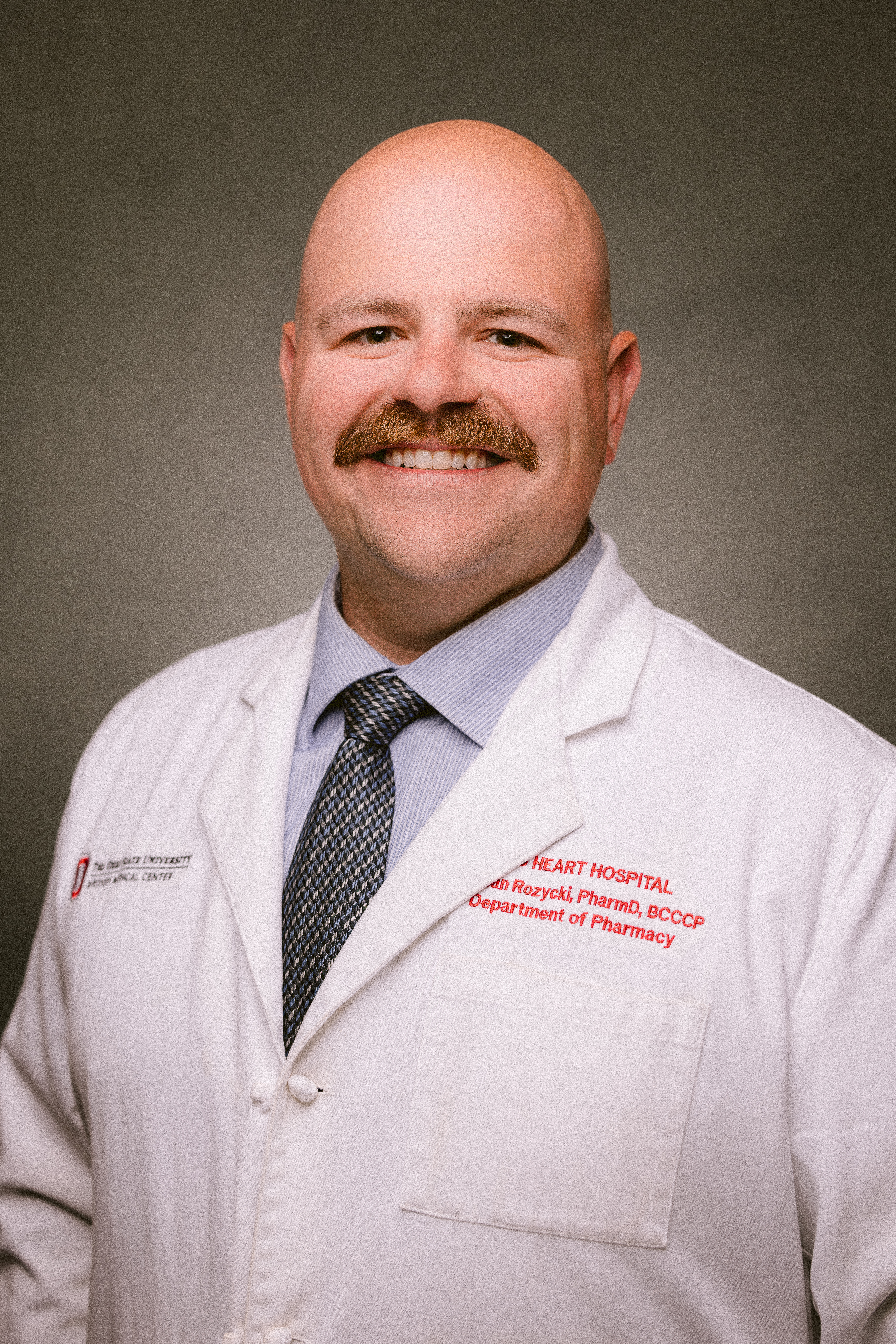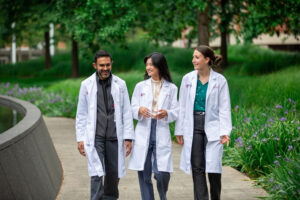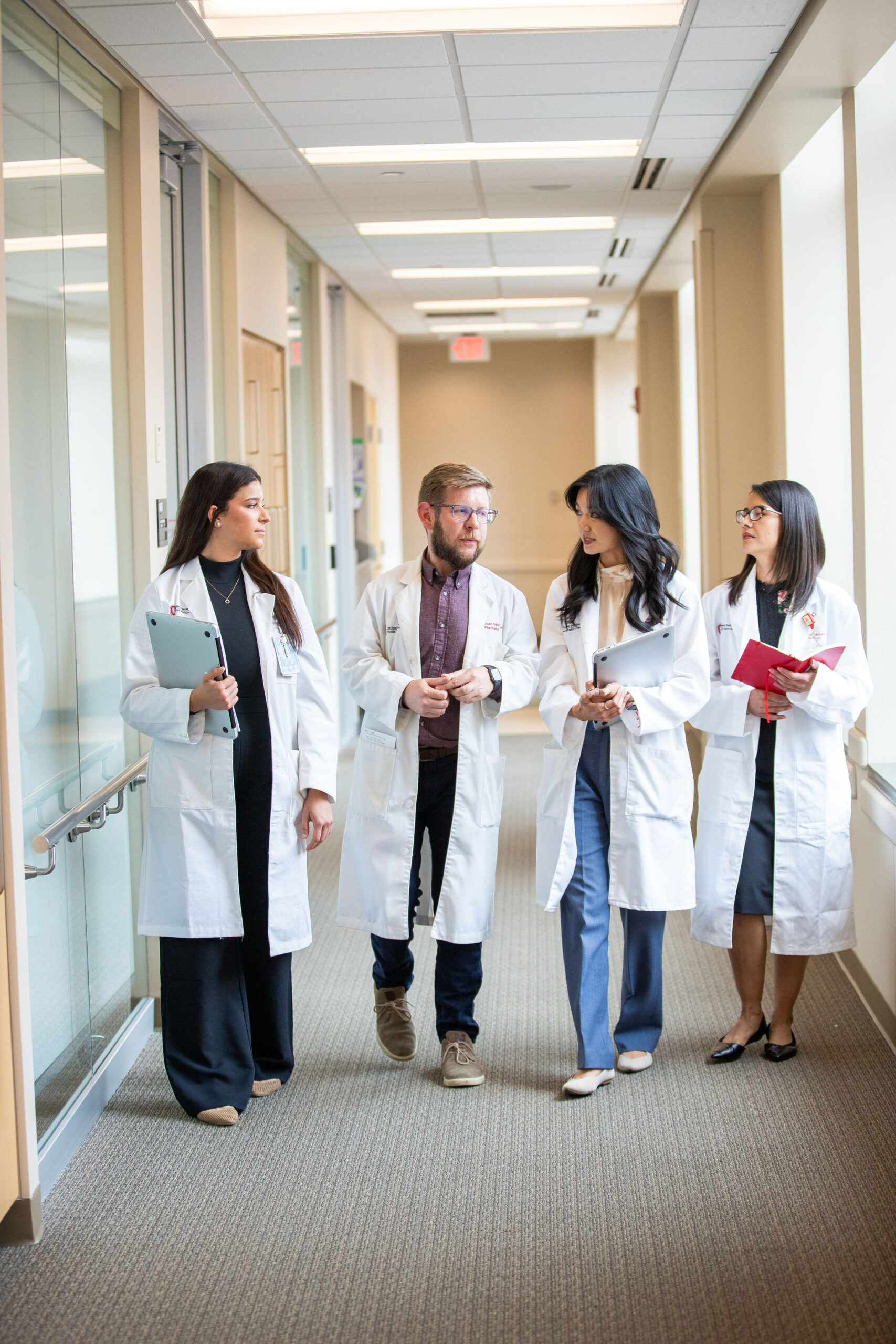PGY1 Program
Residency Program Director
-

Alan Rozycki, PharmD, BCCCP
- PGY1 Pharmacy Residency Program Director, The Ohio State Wexner Medical Center
- Pharmacy Specialist, Cardiovascular Critical Care, The Ohio State University Wexner Medical Center
- PGY1 Pharmacy Practice/PGY2 Critical Care Residency, Johns Hopkins Hospital
- PharmD, Wayne State University
Previous Year Residents
-
Lauren Fortini, PharmD
-
Emily Graves, PharmD
-
Delvin Omer, PharmD
-
Kennedi Satterfield, PharmD
-
Essilvo Sulejmani, PharmD
About the PGY1 Health-System Residency Program
Residency Sites
As one of America’s top ranked academic medical centers, the mission of The Ohio State University Wexner Medical Center (OSUWMC) is to improve people’s lives through innovation in research, education, and patient care. OSUWMC is a 1,506 bed multihospital delivery system recognized in 2018 as one of “America’s Best Hospitals” for excellence in ten specialties by US News and World Report based on quality, outcomes, and reputation.
More about the sites
University Hospital (UH)
University Hospital (UH) is our flagship hospital with over 900 beds. UH is a major referral center for patients throughout Ohio and the Midwest, and is one of the busiest kidney and pancreas transplant centers in the world. UH is also an international center for neuromodulation research and neurological care. In addition, UH is a level 1 trauma center in addition to being the American Burn Associated verified adult burn center for the region
The James Cancer Hospital and Solove Research Institute
The OSUCCC – James strives to create a cancer-free world by integrating scientific research with excellence in education and patient-centered care — a strategy that leads to better methods of prevention, detection and treatment. Ohio State is one of 51 National Cancer Institute (NCI)-designated Comprehensive Cancer Centers and one of only a few centers funded by the NCI to conduct both phase I and phase II clinical trials on novel anticancer drugs sponsored by the NCI. As the cancer program’s 356-bed adult patient-care component, The James is one of the top cancer hospitals in the nation as ranked by U.S. News & World Report and has achieved Magnet® designation, the highest honor an organization can receive for quality patient care and professional nursing practice. With 21 floors and more than 1.1 million square feet, The James is a transformational facility that fosters collaboration and integration of cancer research and clinical cancer care.
The Ross Heart Hospital
The Ross Heart Hospital is a leader in cardiology and heart surgery and is the only nationally ranked heart hospital in the area. Each floor of the 150-bed hospital is dedicated to a specific service, which helps us provide specialized care for every patient. The Ross is one of the largest centers for the implantation of LVAD devices in the world in addition to providing heart and lung transplants.
University Hospitals East (UHE)
University Hospitals East (UHE) blends the friendly atmosphere of a community hospital with the advantages of being a part of a major academic medical center. Located on the eastern edge of downtown Columbus, University Hospital East offers renowned Ohio State services in orthopedic care, emergency services, cancer care, addiction services, ear, nose and throat care, heart care, radiology and imaging services, rehabilitation and wound healing. University Hospital East has a 19 bed mixed medical/surgical ICU.
Harding Hospital/Dodd Hall
In addition, the OSUWMC boasts Harding Hospital, which offers comprehensive inpatient and outpatient mental and behavioral health services in addition to Dodd Hall, which is a nationally recognized and accredited rehabilitation program specializing in stroke, brain, and spinal cord rehabilitation.
The Brain and Spine Hospital
The Brain and Spine Hospital opened in the Fall of 2016 and is a state-of-the-art facility for the advanced management, care and healing of patients with neurological disorders.The hospital consists of 87 private beds and specialized units for stroke and neurovascular, neurotrauma, epilipsy, spine, chronic pain, neuromodulaton, multiple sclerosis, congnitive and movement disorders, as well as an innovative new model for acute spinal cord injuries.
The Department of Pharmacy
The Department of Pharmacy at The OSUWMC is one of the largest in the country. With over 400 employees, and a practice model that includes both clinical pharmacy generalists and clinical pharmacy specialists, our goal is the provision of outstanding, state of the art care. We advise our staff on the best use of medications, develop safeguards for our patients to prevent medication errors and develop transformative pharmacy practice in health-systems. We are guided in this mission by our strategic plan that focuses on five key priorities: optimizing our pharmacy information system, refining our practice model, enhancing our medication safety program, establishing the pharmacy as a workplace of choice in Central Ohio and refining our academic relationships and department scholarship.
Training future generations of pharmacists is a vital part of our mission. Our pharmacists serve as preceptors for our residency programs while providing experiential training for Doctor of Pharmacy (PharmD) students. Our residency program has a 55-year tradition of excellence with our graduates being well-prepared to work at a high-level in a wide-variety of institutional and ambulatory patient care facilities.
The Department of Pharmacy, in partnership with the OSU College of Pharmacy, strives to develop the skills of our residents and provide a residency program that is recognized nationally for the quality and excellence of its graduates.
KEY ROTATIONS/EXPERIENCES
 Rotational experience is designed to provide the resident with broad exposure to pharmacy services, patient populations, teaching, and research and is the backbone of the PGY1 Residency experience. The following month long rotations are required to experience at some point during the PGY1 year: Administration, Ambulatory Care, Critical Care, Internal Medicine, and Oncology. Although these are required, the structure of the resident’s rotation schedule and the type of rotation selected to meet this requirement will be tailored to each resident. Required resident learning experiences are listed in Table 1 of the PGY1 Program Description Document below and slight differences between the PGY1, HSPAL, SPAL, IDR, and Pharmacotherapy residents are noted.
Rotational experience is designed to provide the resident with broad exposure to pharmacy services, patient populations, teaching, and research and is the backbone of the PGY1 Residency experience. The following month long rotations are required to experience at some point during the PGY1 year: Administration, Ambulatory Care, Critical Care, Internal Medicine, and Oncology. Although these are required, the structure of the resident’s rotation schedule and the type of rotation selected to meet this requirement will be tailored to each resident. Required resident learning experiences are listed in Table 1 of the PGY1 Program Description Document below and slight differences between the PGY1, HSPAL, SPAL, IDR, and Pharmacotherapy residents are noted.
RESIDENT RESEARCH
BENEFITS AND ADDITIONAL REQUIREMENTS
Application Deadline: January 2, 2025
We welcome applications from non-U.S. citizens who have a “green card” (permanent resident status) or a current visa valid through the entire duration of the residency program. The Ohio State University pharmacy residency programs are NOT able to sponsor visas for pharmacy residents (PGY1 or PGY2).
Required Supplemental Material:
- Supplemental Application
- Please use supplemental application link above. Applicants must upload supplemental documents to PhORCAS.
- Along with your application, we require three letters of recommendation. It is highly recommended that one to two of the letters be from a clinical rotation APPE preceptor.
Start Date: June 16, 2025
Annual Salary – $55,000
Vacation Days – 10 days
Holidays – 8 days
Staffing Requirement – 24 weekends per year


